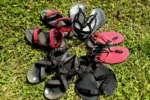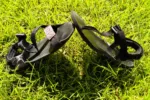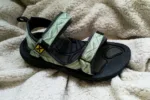Hiking sandals vs boots: Your complete guide
This post may contain affiliate links. This means that we may receive a small commission from purchases through those links. Read more in our affiliate disclosure.
As the sun peaks over the horizon and the wilderness awakens, my fellow explorers lace up their heavy boots—while my toes wiggle in the gentle morning breeze, in the comfort of my trusty hiking sandals. A debate unfolds: Are boots the reigning kings of the trail, or can sandals give them a run for their money?
Hiking sandals are the clear winners in terms of breathability, versatility, and comfort, especially in warm conditions and trails with water crossings. They offer potential benefits for foot health, cause fewer blisters, and can get you surprisingly far. Boots outperform in very rugged terrains, cold (especially snowy) weather, and situations requiring added foot protection and ankle support.
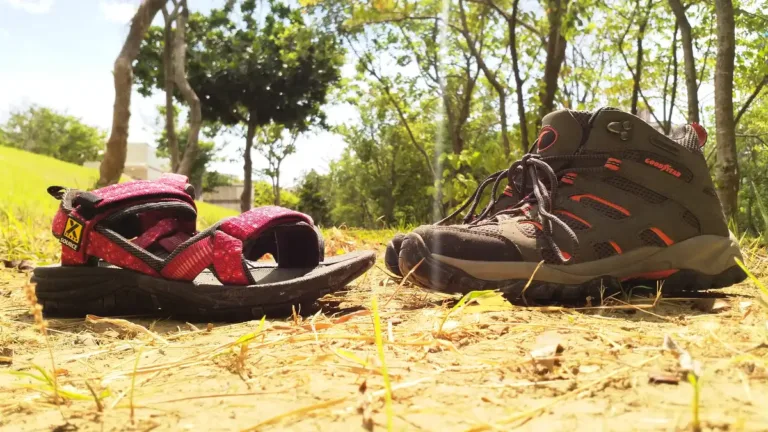
The right shoes can enhance your hiking experience, while an inappropriate pair can detract from the enjoyment of your adventure. Here’s everything you need to consider:
- Introduction
- Hiking sandals vs hiking boots: What to consider
- Comfort of hiking sandals vs boots
- Break-in periods of hiking sandals vs boots
- Fit of hiking sandals vs boots
- Durability of hiking sandals vs boots
- Blisters in hiking sandals vs boots
- Different Hiking conditions in sandals vs boots
- Water crossings
- Sand and pebbles
- Hot weather
- Cold weather
- Mud and slippery slopes
- Loose Rocks
- Sturdy rocks
- Safety and protection
- Social perception
- Weight of hiking sandals vs boots
- Packability of sandals vs boots
- Impact of hiking sandals and boots on foot health
- Conclusion
Hiking sandals vs hiking boots: What to consider
Table of Contents
Comfort of hiking sandals vs boots
Hiking sandals are incredibly comfortable, especially in warmer conditions. They’re open and airy, and give your feet the chance to breathe, unlike hiking boots, which quickly turn your feet sweaty.
Hiking sandals provide freedom for your toes and allow them to wiggle. The design of many sandal models also lets them flex more easily with your foot, so that your feet and toes can behave naturally. It feels infintely better!
Sandals win this one!
Sandals
1
Boots
0
Break-in periods of hiking sandals vs boots
To break in a new pair of hiking boots, you can expect to spend at least a few weeks to break them in. Heavy-duty leather boots typically take the longest—sometimes up to several months of regular use.
With sandals, you get to skip the whole “my boots are eating my toes” experience. Since they are more flexible by construction, many models are ready to hit the trail right away.
For example, my Source Gobi sandals are always ready to right out of the box—although they still soften a bit over time. With other models, like the Shamma Warrior Maximus, I’ve needed maybe a two week break-in period until they were fully molded to my feet.
Another one for the sandals!
Sandals
2
Boots
0
Fit of hiking sandals vs boots
Since sandals have fewer contact points to your foot, I’ve found that it’s much easier to find a sandal that fits really well. Every foot is different, and adjustable sandal straps make it more likely to find a sandal that’s a perfect match for your foot shape.
You can even go further and alter them by yourself. For example, I got a size larger on these Xero Amuri Z-Treks to accommodate my wide feet, and cut the sole to match my toes exactly:
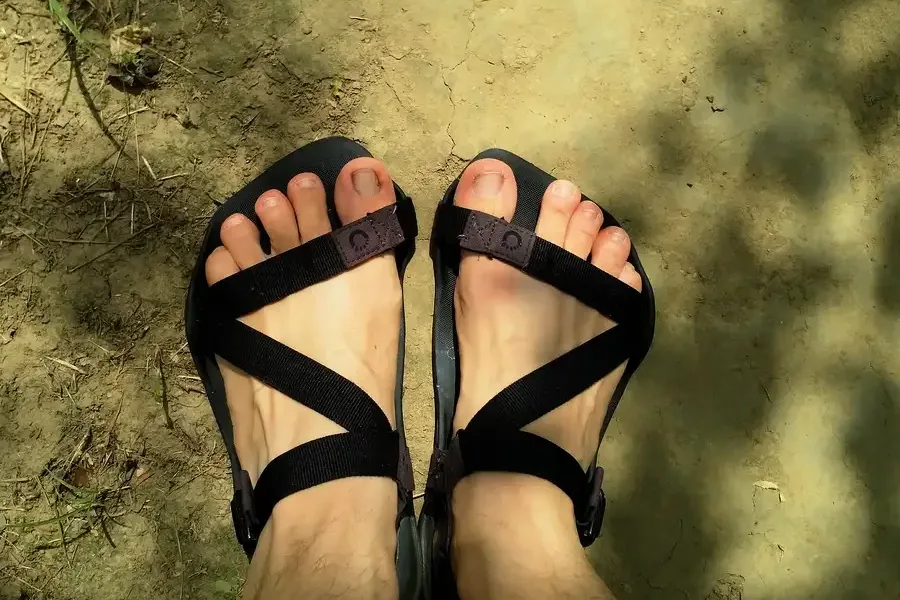
Sandals
3
Boots
0
Durability of hiking sandals vs boots
When it comes to durability, boots usually have the upper hand—or should I say foot—over sandals. They’re typically crafted from sturdy materials like leather or hard-wearing synthetics that stand up well to rough trails, sharp rocks, and all the other bits and bobs mother nature throws at them. With proper care, a good pair of hiking boots can last you several years, even with regular use.
Sandals, while designed to endure the rigors of outdoor adventure, still have their weak points. In my experience, the first thing to go are often the straps, disconnecting from the sole after about a year of heavy everyday use. (And suddenly you find yourself, barefoot, looking for a shoe-maker who can fix it on a bustling market in Indonesia while not speaking the language. That was…adventurous.) At least they can often be fixed.
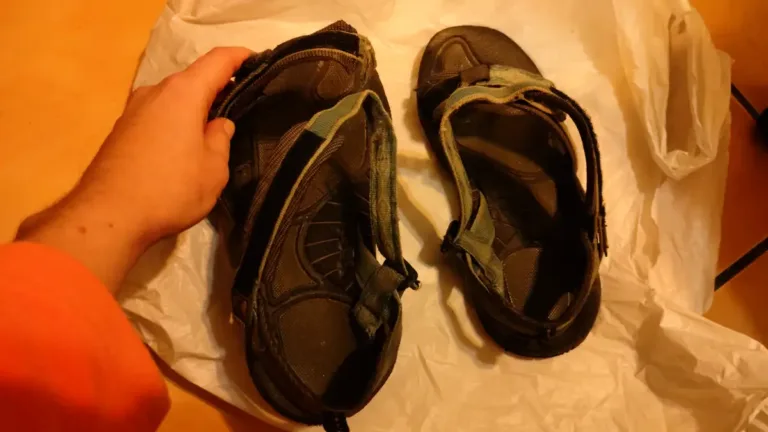
Finally, a point for the boots!
Sandals
3
Boots
1
Blisters in hiking sandals vs boots
Since boots are fairly rigid and inflexible, they can easily cause continuous friction against the skin, which—especially under wet conditions—leads to blisters. You can prevent this by finding a boot that fits really well—not too tight or too lose, just snug enough around the heel—and taking your time breaking it in. Good hiking socks and plasters also help a lot.
Hiking sandals, on the other hand, are lighter, more flexible and easier to adjust—so that a well-fitting hiking sandal should not rub against your skin at all. The way your foot bends, the sandal bends, no friction. Plus, in sandals your feet don’t get sweaty, which is also really helpful against blisters.
Still, just like with boots, you need to choose your sandals well—make sure the straps are not bothering you, especially around the ankles, and that they are padded where you need padding.
Sandals
4
Boots
1
Different Hiking conditions in sandals vs boots
Water crossings
Nothing squishes quite like a soaked boot. If you’ve ever crossed a river in boots, you know that feeling of having a puddle around your feet, which is not only uncomfortable, but also weighs them down—a real drain on your endurance.
This is where hiking sandals really shine. They don’t hold water and dry within a few minutes. Plus, most hiking sandals have antimicrobial treatments, so you won’t have to deal with those not-so-fresh odors even after your feet take a dip.
Just make sure your sole has good traction if you plan on traversing (or tracing!) rivers. And don’t point out your clean, dry feet to your fellow hikers while their boots still go squish-squish-squish. They hate that.
Sand and pebbles
Sandals are your friends when it comes to shaking out those pesky pebbles or sand that sneak in—just a little foot jiggle and you’re good to go. On the other hand, try getting a stone out of your boot without a complete de-shoeing operation.
Long hikes in sharp sand are a different issue, though. Unless you’re wearing high boots with gaiters, that gritty stuff will eventually rub you the wrong way.
Hot weather
When it’s hotter than a goat’s butt in a pepper patch, sandals are your best bet. They offer natural cooling—letting air in and sweat out.
Cold weather
Clearly, when it’s freezing, a boot’s insulation (and water-proof-ness, hopefully!) feels amazing, while in sandals it can get quite chilly.
In cases where it’s only cold for part of the hike—like up a tropical mountain—you can still get away with sandals and good socks. Unless it’s wet. Trust me, the feeling of melting snow seeping into your socks is something I wouldn’t wish on my worst enemy.
Mud and slippery slopes
When it gets muddy, you want a deep profile, so boots are your best bet. There are some rugged hiking sandals with quite good profiles too. But even then, you have to consider that the mud will also grease up the surface between your foot and sole—double slippery! I definitely recommend boots or running shoes in such conditions.
Loose Rocks
On a path full of loose gravel, you’d want a good, sturdy boot. Especially those big, sharp, loose rocks where you trip on one and hit your feet into the next—only boots can save you from that.
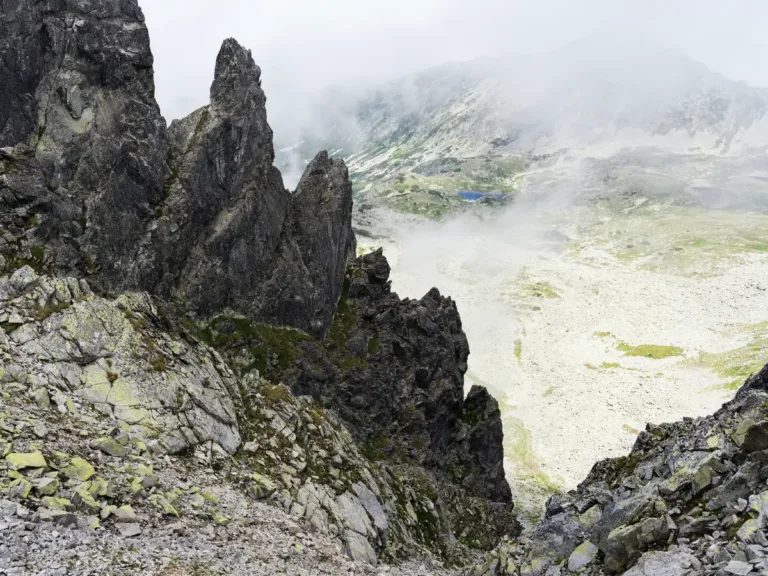
(Image credit: iuliu illes)
Sturdy rocks
On a mountain made of steep but solid, sturdy rocks and roots on the other hand, both boots and sandals are prefectly good options. Hiking sandals aren’t just for your typical light, uneventful stroll on even ground—scaling up steep, rocky climbs is fun in them, too!
Tallying up the clear wins here—hey, the boots almost caught up!
Sandals
5
Boots
4
Safety and protection
Safety first, folks! Hiking sandals do come with an increased risk of stubbed toes and can leave you exposed to the unpleasantries of sticks, rocks, and brush if you’re venturing through dense vegetation. Also, you might find yourself being a snack for bugs—or even a target for snakes. Boots offer a comforting cocoon of protection around your feet from all of that.
And then of course—boots offer ankle support, protecting you from sprained ankles; while sandals do no such thing. But it’s not quite as clear cut: Hiking sandals allow your feet to move more naturally and can actually help strengthen your ankles over time. The next time you step on your doorstep at a weird angle, you probably won’t have a boot on to save you. Wouldn’t it be cool if your ankles were strong and flexible enough to deal with that?! In that sense, one might argue that sandals could actually help prevent ankle sprains.
But still, the point for foot protection goes to the boots. Sandals, watch out!
Sandals
5
Boots
5
Social perception
When you wear sandals on a mountain top, you will get some stange looks from fellow hikers. Here’s a conversation I’ve had multiple times: “Don’t you have boots?!” – “Oh I do, look, here, strapped to my backpack just in case!” (I ended up not using the boots at all out of pure stubborness after all that.) But, yeah, if it bothers you to be judged by other people, don’t go too crazy with where you take your sandals.
Sandals
5
Boots
6
Weight of hiking sandals vs boots
Light as a feather! Well, not exactly, but hiking sandals can be significantly lighter than hiking boots or even trail runners. And every step you take, you’re lifting that weight. Over a long distance, those few extra grams really add up and have a significanct impact on your endurance—much more so than a similar weight saving on your backpack! That makes sandals ideal for long hikes.
The weight of hiking sandals varies from about 600g (~20 ounces) for your average sturdy, well-cushioned models with thick soles, down to as little as 306g (10.8 ounces) for the Xero Z-Trails and even 130g (4.6 ounces) for the Xero Amuri Cloud, which has an ultra-thin sole, but is still sturdy enough for long hikes!
It’s always a balance between comfort and weight, and everyone has their own preferences.
Sandals
6
Boots
6
Packability of sandals vs boots
Do you plan to go on some nice hikes during your vacation? Then the pack volume of your footwear really matters (assuming you don’t want to wear your boots on the plane). Sandals can be flattened down to pretty much just the thickness of their sole, and take up way less space than bulky, sturdy hiking boots. There are even really thin sandals that almost take up no space at all!
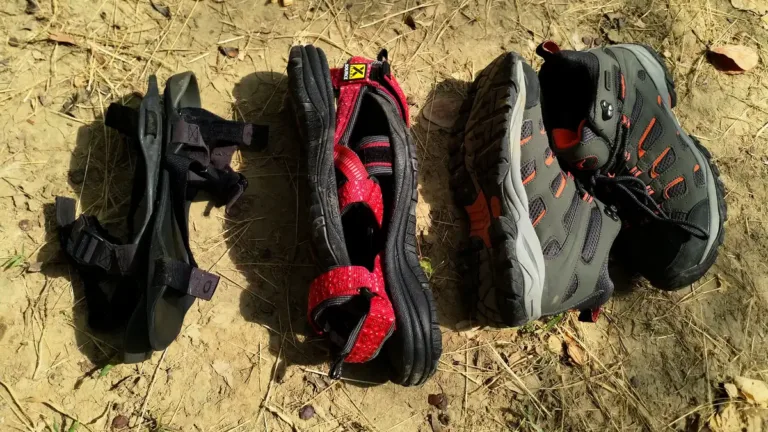
Sandals
7
Boots
6
Impact of hiking sandals and boots on foot health
Now, this here is a somewhat more controversial topic (and I feel like I should throw in a disclaimer of “I’m not a doctor, just a girl who likes sandals, make your own decisions.”). But I’m a firm believer that a healthy foot is a strong foot, and a strong foot is one that has the ability to move in its natural ways on a regular basis—and it can’t do that while confined in a boot. In a sandal—especially the thin, flexible, barefoot-style kind—all these little foot muscles receive training every time you walk. That can protect you against flat feet, or over- and under-pronation.
This has one caveat—you have to start slowly. If you’ve never worn anything but boots, don’t jump into thin hiking sandals and try to scale Mount Everest. Those muscles I mentioned need to grow, slowly, so give them time. Walk around the neighbourhood at first. See how it feels.
Nevertheless, in my opinion, this is a massive plus for the hiking sandals!
Sandals
8
Boots
6
Conclusion
Yay, the sandals won!
Which is to be expected, because I love hiking sandals, and I decided how to split the categories, so.
But nevertheless, I hope this article has given you insight into all the aspects you need to consider when choosing your footwear—taking into account the terrain you plan to hike on, the climate, and how much importance you assign to each of the points we discussed.
If I’ve convinced you to join the way of the sandal, and you want to learn more about how to choose a hiking sandal—click here!

